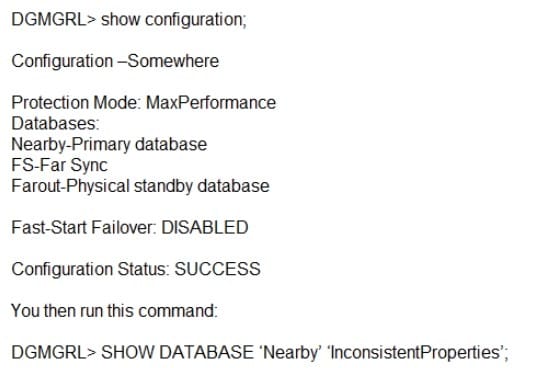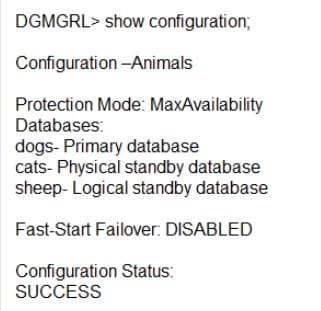Exam Details
Exam Code
:1Z0-066Exam Name
:Oracle Database 12c: Data Guard AdministratorCertification
:Oracle CertificationsVendor
:OracleTotal Questions
:204 Q&AsLast Updated
:Mar 26, 2025
Oracle Oracle Certifications 1Z0-066 Questions & Answers
-
Question 191:
Which two statements are true about Real-Time Query?
A. Setting STANDBY_MAX_DATA_DELAY =0 requires synchronous redo transport.
B. Disabling Real-Time Query prevents the automatic start of redo apply when a physical standby database is opened READ ONLY.
C. Real-Time Query sessions can be connected to a Far Sync instance.
D. Real-Time Query has no limitations regarding the protection level of the Data Guard environment.
E. A standby database enabled for Real-Time Query cannot be the Fast-Start Failover target of the Data Guard configuration.
-
Question 192:
Which three are true concerning restoring of RMAN backups to primary and physical standby databases in a Data Guard environment?
A. Backups of data files taken on the primary database may be restored on a physical standby database.
B. Backups of control files taken on the primary database may not be restored and used on a physical standby database.
C. Backups of SPFILEs taken on a physical standby database may not be restored on the primary database.
D. Backups of control files taken on a physical standby database may be restored on the primary database.
E. Backups of data files taken on a physical standby database may be restored on a pnmary database.
F. Backups of SPFILEs taken on the primary database may not be restored and used on a physical standby database.
-
Question 193:
Examine the Data Guard configuration: DGMGRL > show configuration; Configuration-Animals Protection Mode MaxPerformance Databases dogs-Primary database sheep-Snapshot standby database cats-Snapshot standby database Fast-Start Failover: DISABLED Configuration Status: SUCCESS You receive an error while attempting to raise the protection mode to Maximum Availability: DGMGDRL> edit configuration set protection mode as max availability; Error ORA-16627 operation disallowed since no standby databases would remain to support protection
mode Failed.
Identify two statements that you can execute, either one of which will enable successful raising of the
protection mode to Maximum Availability.
A. DGMGRL> convert database sheep to physical standby;
B. DGMGRL> convert database cats to physical standby;
C. DGMGRL> edit database dogs set property LogXptMode= fastsync;
D. DGMGRL> edit database sheep set property LogXptMode= fastsync;
E. DGMGRL> edit database cats set property LogXptMode= sync;
-
Question 194:
You administer a Data Guard environment with a primary and two physical standby databases.
One of the physical standby databases is used for reporting and is on the same host as the primary database. The other physical standby database is remote, used for disaster recovery and REDO is routed to it via a
far sync instance.
Backups are offloaded to the remote physical standby.
Which three are true concerning the management of archive logs in this Data Guard configuration?
A. Archive logs on the primary database may be deleted once they are applied on all standby databases.
B. Archive logs on the primary database may be deleted once they are shipped on all standby databases.
C. The deletion policy for archive logs on the remote physical standby should be set so that archived logs are deleted once they backed up at least once on the remote physical standby database.
D. The deletion policy for archive logs on the remote physical standby should be set so that archived logs are deleted once they are applied on all standby databases.
E. Archive logs on the primary database may be deleted once they are archived locally to disk.
-
Question 195:
Which three are true regarding the Enterprise Manager Cloud Control Data Guard configuration verification wizard?
A. it checks that supplemental logging is turned on if there is a logical standby database in the configuration.
B. it verifies that parameter settings in the SPFILE or in memory or both, are consistent with the broker configuration properties for that database.
C. It checks that the current data protection level is consistent with the broker's configured data protection mode.
D. it modifies the database configurable parameters to match the values set for the broker configuration.
E. It generates a workload on the primary database causing log switching, and monitors the arrival rate of redo on the standby database.
-
Question 196:
Which two are prerequisites for configuring Transaction Guard in a Data Guard environment?
A. Grant execute permission on the DBMS_APP_CONT package to relevant database schema owners
B. Create a database service with COMMIT_OUTCOME set to TRUE, and ensure clients use that service to connect to the database instance.
C. Ensure that connection descriptors for database clients use the failover clause with the COMMIT_OUTCOME parameter set to TRUE
D. Set INSTANCE_NAME identically on all the Data Guard Configuration databases and modify the local service name on the client to include a CONNECTION_LIST containing all the standby hosts.
E. Create a database service with COMMIT_OUTCOME set to TRUE and ensure that the service is statically registered with the default listener on the primary host
-
Question 197:
You have a Data Guard Broker configuration called Somewhere' as shown: Which two are true about the output of this DGMGRL command?

A. A far sync instance cannot have inconsistent properties because it has no database.
B. It shows all properties whose broker configuration values for database Nearby are inconsistent with the broker configuration values for database Farout.
C. It shows all properties whose broker configuration values for database Nearby are inconsistent with the values in the corresponding server parameter file or the runtime values for database instance Nearby.
D. Any inconsistency reported is on an instance-specific basis.
-
Question 198:
Your Data Guard environment has two remote physical standby databases.
Client applications use the local naming method to define connectivity to the primary database instance.
Which will automatically redirect clients to the new primary database in case of a switchover or failover?
A. Create a database service on the standby databases; automate the start of the service after a role change, and modify the connection description on the clients to use that service.
B. Configure a PRIMARY role service on the Primary and Standby and modify the Client connect descriptor to include both Primary and the Standby.
C. Set the DB_NAME parameter identically on all databases; modify the connection descriptor on the clients to use DB_NAME to connect to the primary database instance.
D. Set the LOCALJJSTENER parameter for all the database instances, to register services with the default listener on the primary database host.
-
Question 199:
Which three steps are prerequisites for the creation of a physical standby database on a separate server using the RMAN active database duplication method?
A. Set the DB_UNIQUE_NAME parameter on the primary database to a different value than that of the DB_NAME parameter.
B. Put the primary database into archivelog mode
C. Startup nomount the standby database instance.
D. Configure Oracle Net connectivity on the primary host to the standby database instance.
E. Establish user equivalence for the database software owner between the primary host and standby host.
-
Question 200:
Examine the Data Guard configuration:

Which three will be true after a switchover to Sheep?
A. Dogs will be an enabled logical standby database.
B. Sheep will be the primary database.
C. Cats will be a disabled physical standby database.
D. Dogs will be a disabled logical standby database
E. Cats will be an enabled physical standby database.
Related Exams:
1Z0-020
Oracle8i: New Features for Administrators1Z0-023
Architecture and Administration1Z0-024
Performance Tuning1Z0-025
Backup and Recovery1Z0-026
Network Administration1Z0-034
Upgrade Oracle9i/10g OCA to Oracle Database OCP1Z0-036
Managing Oracle9i on Linux1Z0-041
Oracle Database 10g: DBA Assessment1Z0-052
Oracle Database 11g: Administration Workshop I1Z0-053
Oracle Database 11g: Administration II
Tips on How to Prepare for the Exams
Nowadays, the certification exams become more and more important and required by more and more enterprises when applying for a job. But how to prepare for the exam effectively? How to prepare for the exam in a short time with less efforts? How to get a ideal result and how to find the most reliable resources? Here on Vcedump.com, you will find all the answers. Vcedump.com provide not only Oracle exam questions, answers and explanations but also complete assistance on your exam preparation and certification application. If you are confused on your 1Z0-066 exam preparations and Oracle certification application, do not hesitate to visit our Vcedump.com to find your solutions here.